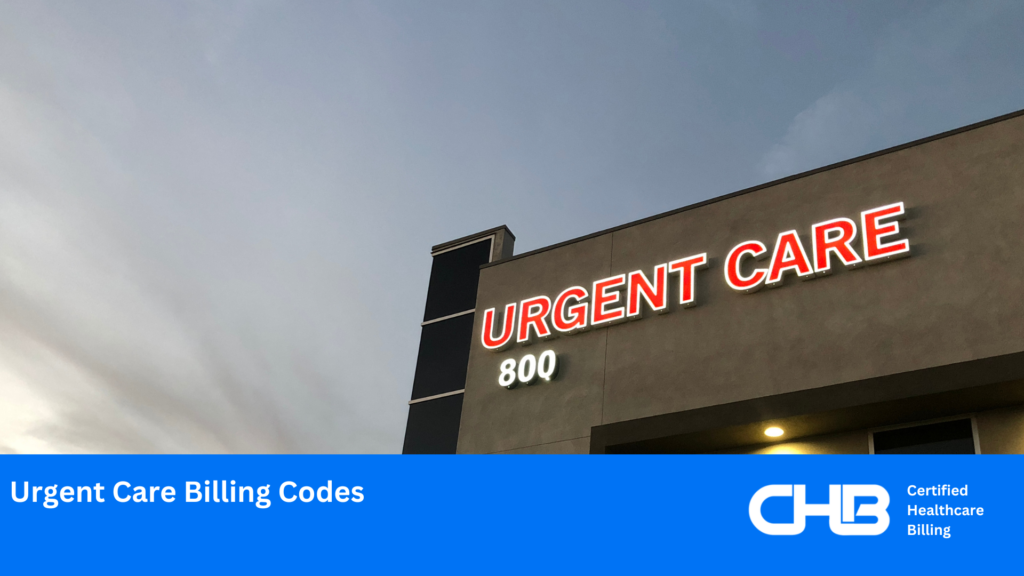
Hey there, fellow urgent care billers!
Let’s talk about the important world of billing codes and how they impact your revenue cycle.
Understanding Urgent Care Billing Codes
You know urgent care is fast-paced, dealing with everything from minor injuries to serious conditions. This variety makes proper coding crucial, so let’s break it down.
Common CPT Codes in Urgent Care
You’re probably familiar with these common CPT codes:
- 99281-99285: Emergency department visits
- 99201-99205: New patient office visits
- 99211-99215: Established patient office visits
Remember, the higher the number, the more complex the visit. It requires more detailed documentation and often results in higher reimbursement.
E/M Coding: The Heart of Urgent Care Billing
E/M codes are essential for urgent care billing. Choosing the right one is critical for accurate reimbursement:
- Level 1 (99201/99211): Minimal complexity
- Level 2 (99202/99212): Low complexity
- Level 3 (99203/99213): Moderate complexity
- Level 4 (99204/99214): High complexity
- Level 5 (99205/99215): Highest complexity
Picking the right E/M code requires considering all aspects – patient history, examination, and medical decision-making.
Modifier Madness: Adding Clarity to Your Claims
You know modifiers are essential, but using them correctly can be tricky. Here are some you probably use often:
-25: Significant, separately identifiable E/M service -59: Distinct procedural service -GY: Item or service statutorily excluded or does not meet the definition of any Medicare benefit
Using these modifiers correctly can mean the difference between a paid claim and a denied one.
The ICD-10 Challenge
ICD-10 codes are another crucial piece of the billing puzzle. In urgent care, you might frequently use codes like:
J00-J99: Diseases of the respiratory system S00-T88: Injury, poisoning, and certain other consequences of external causes R00-R99: Symptoms, signs, and abnormal clinical and laboratory findings
Matching these codes accurately with CPT codes is crucial for proper reimbursement.
Tackling Common Urgent Care Billing Challenges
You’ve probably encountered these hurdles before:
- Overcoding or Undercoding: This can lead to compliance issues or lost revenue. Regular audits and staff training can help maintain accurate coding.
- Missing Documentation: You know documentation is key. A robust EMR system and proper staff training can make all the difference.
- Claim Denials: These can significantly impact your revenue. A dedicated denial management process can help reduce and manage them effectively.
Staying Up-to-Date with Billing Changes
You know the billing world is always changing. To stay ahead, consider regular staff training, industry publications, and attending conferences or webinars.
Leveraging Technology for Better Billing
You’re probably already using billing software, but are you maximizing its potential? Modern systems can automate claim submission, flag potential errors, and track claims in real-time.
The Importance of Compliance
You know compliance isn’t just important – it’s essential. This includes HIPAA compliance, accurate coding and documentation, and regular internal audits.
Streamline Your Urgent Care Billing with Certified Healthcare Billing
As a full-service urgent care billing company, Certified Healthcare Billing (CHB) specializes in providing comprehensive medical billing services tailored for urgent care facilities. We understand the unique challenges you face in urgent care billing, from selecting the right E/M codes to managing claim denials.
Our team of experts can help streamline your revenue cycle management (RCM), ensuring accurate coding, timely claim submissions, and maximized reimbursements.
We offer a range of urgent care billing services, including thorough coding reviews to avoid costly mistakes, efficient claims processing, and dedicated denial management.
By partnering with CHB, you can focus on patient care while we take care of your entire billing process. Whether you’re looking to improve your coding accuracy, reduce denials, or optimize your overall RCM, our urgent care billing services are designed to meet your specific needs.
Contact us today to learn how our urgent care billing company can help boost your financial performance and alleviate your billing headaches.

FAQ
What are the most common billing codes used in urgent care?
You probably use CPT codes 99201-99205 for new patients and 99211-99215 for established patients a lot. E/M codes are also your bread and butter, depending on visit complexity.
How often do urgent care billing codes change?
What’s the difference between urgent care and emergency room billing?
You’ve likely noticed urgent care typically uses office visit codes (99201-99215), while ERs use emergency department codes (99281-99285). The level of service and documentation requirements also differ.
How can I reduce claim denials in urgent care billing?
You’re probably already focusing on accurate documentation and proper code selection. Adding timely filing, staying up-to-date with payer policies, and implementing a robust denial management process can also help.
What role does technology play in urgent care billing?
You’re likely using tech to improve billing efficiency through automated claim submission and tracking. It can also provide valuable analytics to boost your billing game.


